Stocks managed to firm on Monday with small gains in the major index ETFs. The Nasdaq 100 ETF (QQQ) and Russell 2000 ETF (IWM) led the way (up .66%). Six of the nine sectors were up with the Basic Materials SPDR (XLB) and Energy SPDR (XLE) leading the way. The Utilities SPDR (XLU) was the hardest hit as it broke support from the October lows. Treasuries stalled within their two week uptrend. The Dollar edged higher and held its breakout. Oil and gold got small oversold bounces within their downtrends. The chart below shows QQQ within a falling channel since early October. The channel trend line and Friday's high mark resistance. A break above these levels is needed to reverse the 7-8 week slide. The indicator window shows the Commodity Channel Index (CCI) with the mid October high marking momentum resistance.
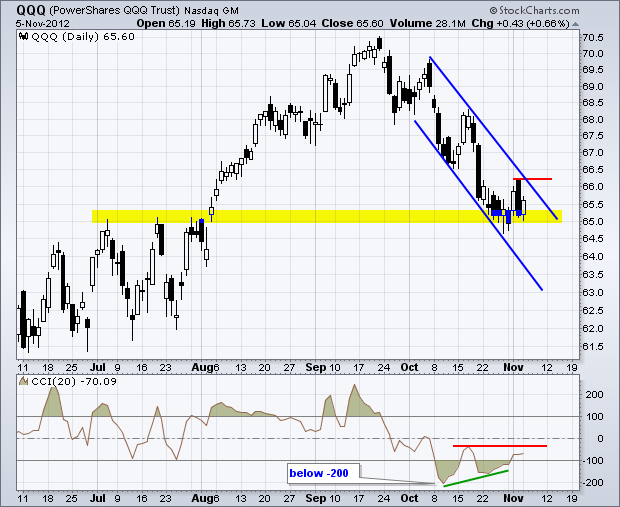


On the 30-minute chart, SPY surged to broken support last week and turned sharply lower on Friday. This decline reinforces resistance in the 143-143.5 area. A breakout here would reverse the 4-5 week downtrend. SPY got a small bounce near the late October lows, but this just looks like an oversold bounce for now. A breakout and strong close above 143.50 is needed to put the bulls back on track.

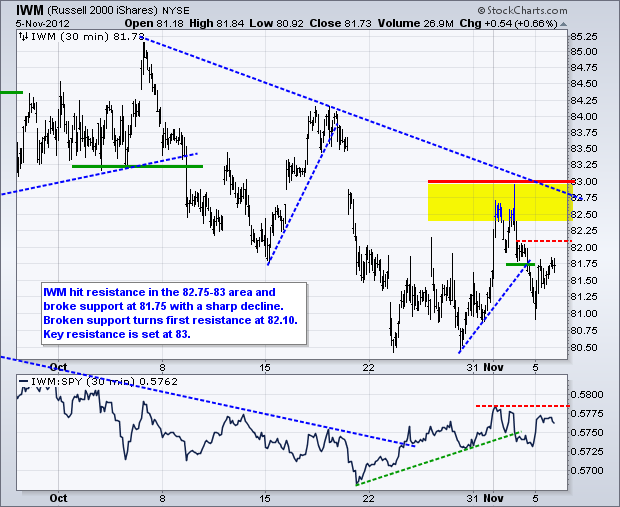
**************************************************************************
No change. The 20+ Year T-Bond ETF (TLT) has been trending lower since late July and since late September. I am showing a 60-minute chart to highlight the falling channel since late September. The swing within this channel is up with support just below 121.50. Given the weakness in stocks, I would have expected TLT to be above its mid October high by now. But it isn't. A break above 123.50 would be medium-term bullish for TLT and bearish for stocks. Conversely, a break below upswing support would be short-term bearish for TLT and bullish for stocks. We could see a decisive move on Wednesday.
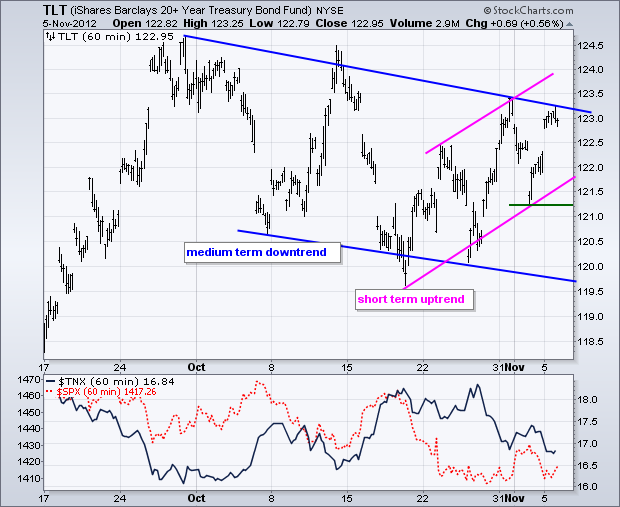
**************************************************************************
No change. The US Dollar Fund (UUP) surged to resistance in late October, consolidated and broke out with a surge on Friday. Perhaps the prospects of less quantitative easing triggered this buying binge. An improving economy and labor market put less pressure on the Fed for quantitative easing, which means less Dollar dilution. I am showing a longer 60-minute chart to highlight the magnitude of this breakout, which is medium-term bullish. Broken resistance turns first support in the 21.95 area. Key support is set at 21.85 for now.
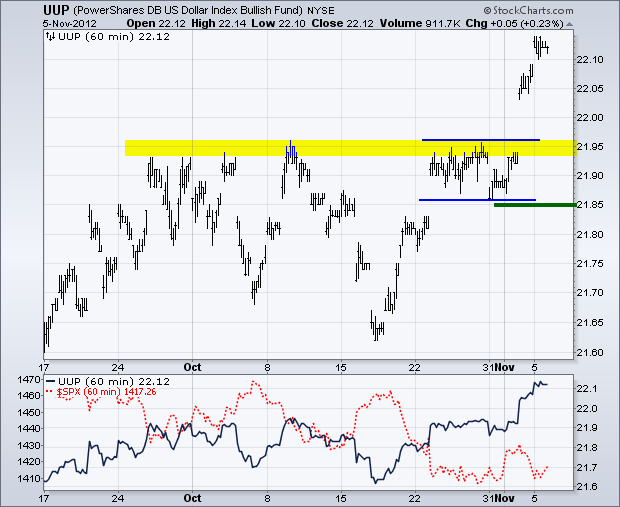
**************************************************************************
No change. The US Oil Fund (USO) formed a rising flag in late October and broke flag support with a sharp decline on Friday. The flag high now marks first resistance at 32.30. The bigger trend is also down with the September trend line and broken support marking key resistance at 33.50. Oil is under pressure because stocks are weak and the Dollar is strong.

**************************************************************************
No change. The Gold SPDR (GLD) got an oversold bounce in late October, but this bounce formed a rising wedge and the ETF broke wedge support on Wednesday-Thursday. Selling pressure surged on Friday as the Dollar broke resistance and stocks moved sharply lower. Broken support and the wedge high mark resistance in the 167-168 area. GLD is oversold because it moved below the lower trend line of the falling channel. This may produce an oversold bounce back to broken support around 165.
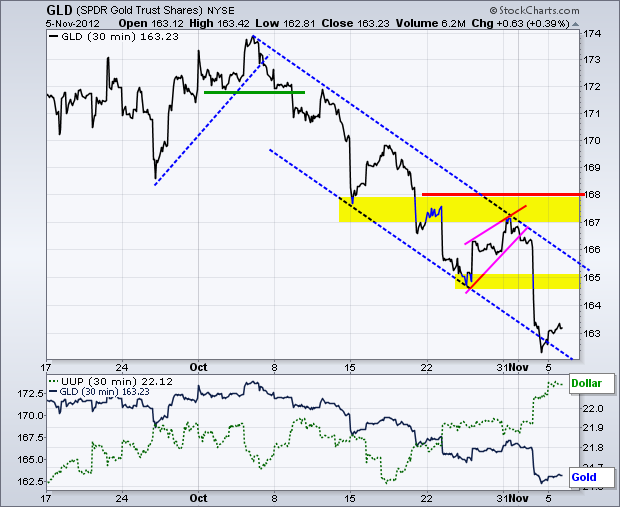
**************************************************************************
Key Reports and Events:
Mon - Nov 05 - 10:00 - ISM Services
Wed - Nov 07 - 07:00 - MBA Mortgage Index
Wed - Nov 07 - 10:30 - Oil Inventories
Thu - Nov 08 - 08:30 - Jobless Claims
Fri - Nov 09 - 09:55 - Michigan Sentiment
Tue - Nov 06 - 08:00 - Election Day
Charts of Interest: Tuesday and Thursday
This commentary and charts-of-interest are designed to stimulate thinking. This analysis is not a recommendation to buy, sell, hold or sell short any security (stock ETF or otherwise). We all need to think for ourselves when it comes to trading our own accounts. First, it is the only way to really learn. Second, we are the only ones responsible for our decisions. Think of these charts as food for further analysis. Before making a trade, it is important to have a plan. Plan the trade and trade the plan. Among other things, this includes setting a trigger level, a target area and a stop-loss level. It is also important to plan for three possible price movements: advance, decline or sideways. Have a plan for all three scenarios BEFORE making the trade. Consider possible holding times. And finally, look at overall market conditions and sector/industry performance.


**************************************************************************
No change. The 20+ Year T-Bond ETF (TLT) has been trending lower since late July and since late September. I am showing a 60-minute chart to highlight the falling channel since late September. The swing within this channel is up with support just below 121.50. Given the weakness in stocks, I would have expected TLT to be above its mid October high by now. But it isn't. A break above 123.50 would be medium-term bullish for TLT and bearish for stocks. Conversely, a break below upswing support would be short-term bearish for TLT and bullish for stocks. We could see a decisive move on Wednesday.

**************************************************************************
No change. The US Dollar Fund (UUP) surged to resistance in late October, consolidated and broke out with a surge on Friday. Perhaps the prospects of less quantitative easing triggered this buying binge. An improving economy and labor market put less pressure on the Fed for quantitative easing, which means less Dollar dilution. I am showing a longer 60-minute chart to highlight the magnitude of this breakout, which is medium-term bullish. Broken resistance turns first support in the 21.95 area. Key support is set at 21.85 for now.

**************************************************************************
No change. The US Oil Fund (USO) formed a rising flag in late October and broke flag support with a sharp decline on Friday. The flag high now marks first resistance at 32.30. The bigger trend is also down with the September trend line and broken support marking key resistance at 33.50. Oil is under pressure because stocks are weak and the Dollar is strong.

**************************************************************************
No change. The Gold SPDR (GLD) got an oversold bounce in late October, but this bounce formed a rising wedge and the ETF broke wedge support on Wednesday-Thursday. Selling pressure surged on Friday as the Dollar broke resistance and stocks moved sharply lower. Broken support and the wedge high mark resistance in the 167-168 area. GLD is oversold because it moved below the lower trend line of the falling channel. This may produce an oversold bounce back to broken support around 165.

**************************************************************************
Key Reports and Events:
Mon - Nov 05 - 10:00 - ISM Services
Wed - Nov 07 - 07:00 - MBA Mortgage Index
Wed - Nov 07 - 10:30 - Oil Inventories
Thu - Nov 08 - 08:30 - Jobless Claims
Fri - Nov 09 - 09:55 - Michigan Sentiment
Tue - Nov 06 - 08:00 - Election Day
Charts of Interest: Tuesday and Thursday
This commentary and charts-of-interest are designed to stimulate thinking. This analysis is not a recommendation to buy, sell, hold or sell short any security (stock ETF or otherwise). We all need to think for ourselves when it comes to trading our own accounts. First, it is the only way to really learn. Second, we are the only ones responsible for our decisions. Think of these charts as food for further analysis. Before making a trade, it is important to have a plan. Plan the trade and trade the plan. Among other things, this includes setting a trigger level, a target area and a stop-loss level. It is also important to plan for three possible price movements: advance, decline or sideways. Have a plan for all three scenarios BEFORE making the trade. Consider possible holding times. And finally, look at overall market conditions and sector/industry performance.

About the author:
Arthur Hill, CMT, is the Chief Technical Strategist at TrendInvestorPro.com. Focusing predominantly on US equities and ETFs, his systematic approach of identifying trend, finding signals within the trend, and setting key price levels has made him an esteemed market technician. Arthur has written articles for numerous financial publications including Barrons and Stocks & Commodities Magazine. In addition to his Chartered Market Technician (CMT) designation, he holds an MBA from the Cass Business School at City University in London.
Learn More





